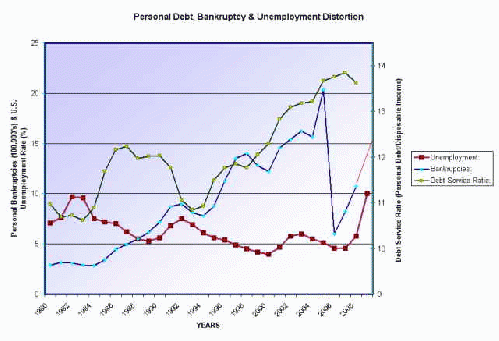My analysis of three indicators shows that within 12 months the annualized number of personal bankruptcies will roar past 1.5 million.
I believe this is a conservative estimate. The actual number may top the 2005 record of 2 million U.S. filings, which was set in the rush to beat the implementation of the Bankruptcy Abuse Prevention and Consumer Protection Act.
To make this forecast I looked at three sets of data: historic bankruptcy filing numbers, provided by the Administrative Office of the U.S. Courts, and historic unemployment rates and the personal debt service ratio (DSR) both provided by the Bureau of Labor Statistics.
The graph below tells the story of how these trends interact.
After the 1983 recession, when unemployment flirted with 10%, families increase their debt ratio from 10.5% to just over 12%. Bankruptcies soon increased, but with improving employment over the next 10 years, the debt ratio plummets.
From 1995, bankruptcies skyrocket, and in spite of the debt write-offs, so too does the debt ratio, from 11% to nearly 14%. Loose lending, exuberant spending and slack real income gains all contribute to raising debt. The record numbers of bankruptcies between 1996 and 2005 do nothing to stem the tide of red ink.
In 2008, the distortion of the situation becomes apparent. High personal debt and high unemployment, the double engine bankruptcy freight train is on the tracks. Fuel for this train is increasing with credit card companies currently doubling interest rates from 15% to 30%, which more than doubles actual interest accumulation.
This analysis forces many questions upon us, including: When and how will Main Street emerge from the Great Recession? Will the Bankruptcy Freight shunt the economy back on track? Or, will it be a head-on, lights-out collision?





